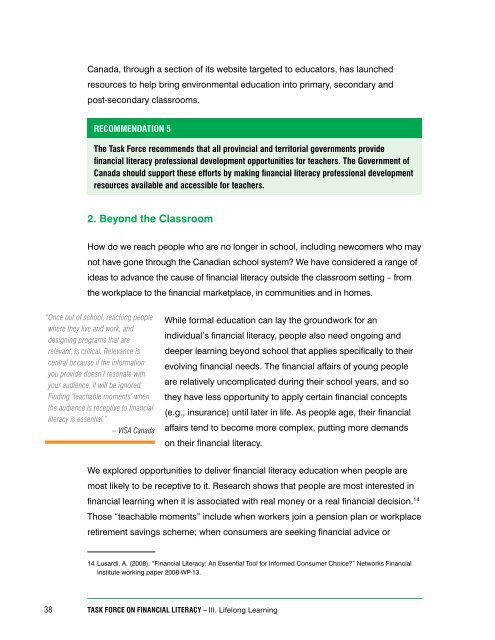Canadians and Their Money
Canadians and their money: building a brighter financial - EduGAINS
Canadians and their money: building a brighter financial - EduGAINS
- No tags were found...
You also want an ePaper? Increase the reach of your titles
YUMPU automatically turns print PDFs into web optimized ePapers that Google loves.
Canada, through a section of its website targeted to educators, has launchedresources to help bring environmental education into primary, secondary <strong>and</strong>post-secondary classrooms.Recommendation 5The Task Force recommends that all provincial <strong>and</strong> territorial governments providefinancial literacy professional development opportunities for teachers. The Government ofCanada should support these efforts by making financial literacy professional developmentresources available <strong>and</strong> accessible for teachers.2. Beyond the ClassroomHow do we reach people who are no longer in school, including newcomers who maynot have gone through the Canadian school system? We have considered a range ofideas to advance the cause of financial literacy outside the classroom setting – fromthe workplace to the financial marketplace, in communities <strong>and</strong> in homes.“Once out of school, reaching peoplewhere they live <strong>and</strong> work, <strong>and</strong>designing programs that arerelevant, is critical. Relevance iscentral because if the informationyou provide doesn’t resonate withyour audience, it will be ignored.Finding ‘teachable moments’ whenthe audience is receptive to financialliteracy is essential.”– VISA CanadaWhile formal education can lay the groundwork for anindividual’s financial literacy, people also need ongoing <strong>and</strong>deeper learning beyond school that applies specifically to theirevolving financial needs. The financial affairs of young peopleare relatively uncomplicated during their school years, <strong>and</strong> sothey have less opportunity to apply certain financial concepts(e.g., insurance) until later in life. As people age, their financialaffairs tend to become more complex, putting more dem<strong>and</strong>son their financial literacy.We explored opportunities to deliver financial literacy education when people aremost likely to be receptive to it. Research shows that people are most interested infinancial learning when it is associated with real money or a real financial decision. 14Those “teachable moments” include when workers join a pension plan or workplaceretirement savings scheme; when consumers are seeking financial advice or14 Lusardi, A. (2008). “Financial Literacy: An Essential Tool for Informed Consumer Choice?” Networks FinancialInstitute working paper 2008-WP-13.38TASK FORCE ON FINANCIAL LITERACY – III. Lifelong Learning
















